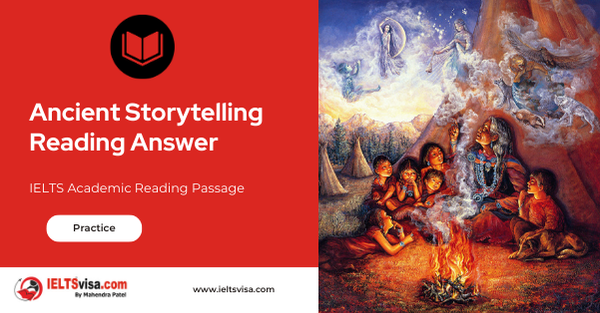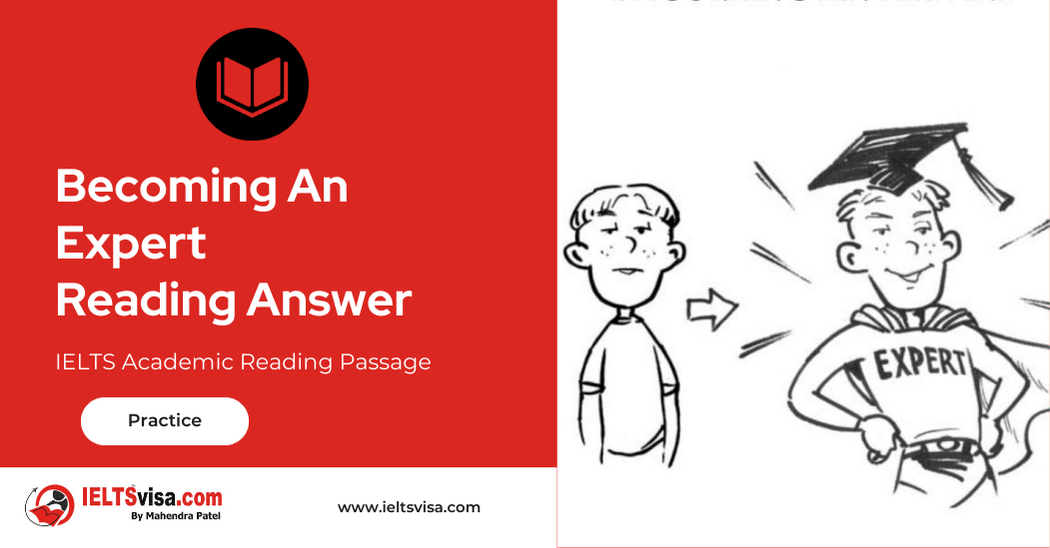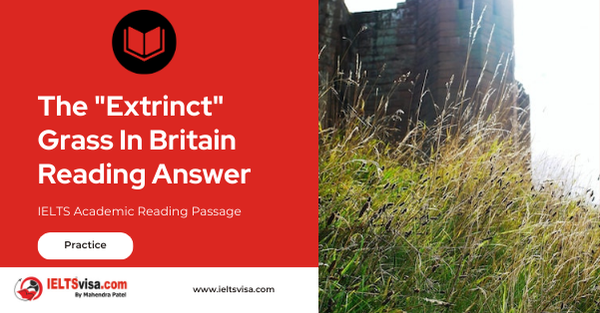Ancient Storytelling Reading Answer
IELTS Academic Reading Passage
A
It was told, we suppose, to people crouched around a fire: a tale of adventure, most likely- relating some close encounter with death; a remarkable hunt, an escape from mortal danger; a vision, or something else out of the ordinary. Whatever its thread, the weaving of this story was done with a prime purpose. The listeners must be kept listening. They must not fall asleep. So, as the story went on, its audience should be sustained by one question above all. What happens next?
B
The first fireside stories in human history can never be known. They were kept in the heads of those who told them. This method of storage is not necessarily inefficient. From documented oral traditions in Australia, the Balkans and other parts of the world we know that specialised storytellers and poets can recite from memory literally thousands of lines, in verse or prose, verbatim-word for word. But while memory is rightly considered an art in itself, it is clear that a primary purpose of making symbols is to have a system of reminders or mnemonic cues – signs that assist us to recall certain information in the mind’s eye.
C
In some Polynesian communities, a notched memory stick may help to guide a storyteller through successive stages of recitation. But in other parts of the world, the activity of storytelling historically resulted in the development or even the invention of writing systems. One theory about the arrival of literacy in ancient Greece, for example, argues that the epic tales about the Trojan War and the wanderings of Odysseus – traditionally attributed to Homer – were just so enchanting to hear that they had to be preserved. So the Greeks, c.750-700BC, borrowed an alphabet from their neighbors in the eastern Mediterranean, the Phoenicians.
D
The custom of recording stories on parchment and other materials can be traced in many manifestations around the world, from the priestly papyrus archives of ancient Egypt to the birch-bark scrolls on which the North American Ojibway Indians set down their creation- myth. It is a well-tried and universal practice: so much so that to this day storytime is probably most often associated with words on paper. The formal practice of narrating a story aloud would seem-so we assume to have given way to newspapers, novels and comic strips. This, however, is not the case. Statistically, it is doubtful that the majority of humans currently rely upon the written word to get access to stories. So what is the alternative source?
E
Each year, over 7 billion people will go to watch the latest offering from Hollywood, Bollywood and beyond. The supreme storyteller of today is cinema. The movies, as distinct from still photography, seem to be an essential modem phenomenon. This is an illusion, for there are, as we shall see, certain ways in which the medium of film is indebted to very old precedents of arranging ‘sequences’ of images. But any account of visual storytelling must be with the recognition that all storytelling beats with a deeply atavistic pulse: that is, a ‘good story’ relies upon formal patterns of plot and characterisation that have been embedded in the practice of storytelling over many generations.
F
Thousands of scripts arrive every week at the offices of the major film studios. But aspiring screenwriters really need to look no further for essential advice then the fourth-century BC Greek Philosopher Aristotle. He left some incomplete lecture notes on the art of telling stories in various literary and dramatic modes, a slim volume known as The Poetics. Though he can never have envisaged the popcorn-fuelled actuality of a multiplex cinema, Aristotle is almost prescient about the key elements required to get the crowds flocking to such a cultural hub. He analyzed the process with cool rationalism. When a story enchants us, we lose the sense of where we are; we are drawn into the story so thoroughly that we forget it is a story being told. This is, in Aristotle’s phrase, ‘the suspension of disbelief.
G
We know the feeling. If ever we have stayed in our seats, stunned with grief, as the credits roll by, or for days after seeing that vivid evocation of horror have been nervous about taking a shower at home, then we have suspended disbelief. We have been caught, or captivated, in the storyteller’s web. Did it all really happen? We really thought so for a while. Aristotle must have witnessed often enough this suspension of disbelief. He taught at Athens, the city where theater developed as a primary form of civic ritual and recreation. Two theatrical types of storytelling, tragedy and comedy, caused Athenian audiences to lose themselves in sadness and laughter respectively. Tragedy, for Aristotle, was particularly potent in its capacity to enlist and then purge the emotions of those watching the story unfold on the stage, so he tried to identify those factors in the storyteller’s art that brought about such engagement. He had, as an obvious sample for analysis, not only the fifth-century BC masterpieces of Classical Greek tragedy written by Aeschylus, Sophocles and Euripides. Beyond them stood Homer, whose stories even then had canonical status: The Iliad and The Odyssey were already considered literary landmarks-stories by which all other stories should be measured. So what was the secret of Homer’s narrative art?
H
It was not hard to find. Homer created credible heroes. His heroes belonged to the past, they were mighty and magnificent, yet they were not, in the end, fantasy figures. He made his heroes sulk, bicker, cheat and cry. They were, in short, characters – protagonists of a story that an audience would care about, would want to follow, would want to know what happens next. As Aristotle saw, the hero who shows a human side-some flaw or weakness to which mortals are prone-is intrinsically dramatic.d by logging.
Questions 1-5
The Reading Passage has eight paragraphs A-H
Which paragraph contains the following information?
Write the correct letter A-H, in boxes 1-5 on your answer sheet.
1. A misunderstanding of a modern way for telling stories
2. The typical forms mentioned for telling stories
3. The fundamental aim of storytelling
4. A description of reciting stories without any assistance
5. How to make story characters attractive
Questions 6-9
Classify the following information as referring to
A adopted the writing system from another country
B used organic materials to record stories
C used tools to help to tell stories
Write the correct letter, A, B or C in boxes 6-9 on your answer sheet.
6. Egyptians
7. Ojibway
8. Polynesians
9. Greek
Questions 10-13
Complete the sentences below with ONE WORD ONLY from the passage.
Write your answer in boxes 10-13 on your answer sheet.
10. Aristotle wrote a book on the art of storytelling called 10…………………
11. Aristotle believed the most powerful type of story to move listeners is 11…………………
12. Aristotle viewed Homers works as 12…………………
13. Aristotle believed attractive heroes should have some 13…………………

Solution:Ancient Storytelling Reading Answer
| 1. E | 8. C |
| 2. G | 9. A |
| 3. A | 10. Poetics |
| 4. B | 11. tragedy |
| 5. H | 12. landmarks |
| 6. B | 13. flaw |
| 7. B |
Review and Practice
- Regularly practice with IELTS reading samples and time yourself to get used to the pressure of the exam.
- Review your mistakes to understand where you went wrong and how to avoid similar errors in the future.
Our Books
Master IELTS Speaking Part 1
IELTS Writing Task 1 Book
IELTS Writing Task 2 Book
Ancient Storytelling Reading Answer Explanation
| Question No | Question Type | Answer | Keywords | Supporting Sentence | Location of Keywords | Explanation |
|---|---|---|---|---|---|---|
| 1 | Solution and Explanation | E | supreme storyteller, still photography, illusion, old precedents | The supreme storyteller of today is cinema. The movies, as distinct from still photography, seem to be an essential modern phenomenon. This is an illusion, for there are, as we shall see, certain ways in which the medium of film is indebted to very old precedents of arranging ‘sequences’ of images. | lines 2-5 | Cinema has been considered as a modern way of telling stories, and still photography has become the modern phenomenon essential for the same, which is merely an illusion considering that the medium of today’s films are highly indebted or based on arranging the sequences of images. |
| 2 | Solution and Explanation | G | theatrical, tragedy and comedy, Athenian audiences | Two theatrical types of storytelling, tragedy and comedy, caused Athenian audiences to lose themselves in sadness and laughter respectively. | lines 6-8 | Two types of storytelling forms have been mentioned by Aristotle for tragedy and comedy, which are the two forms typical of storytelling. |
| 3 | Solution and Explanation | A | weaving, prime purpose, listening, asleep | The weaving of this story was done with a prime purpose. The listeners must keep listening. They must not fall asleep. | lines 3-5 | The primary purpose of storytelling has been considered with the listeners not falling asleep and continuing to listen. |
| 4 | Solution and Explanation | B | primary purpose, making symbols, reminders, mnemonic cues, mind eye’s | It is clear that a primary purpose of making symbols is to have a system of reminders or mnemonic cues – signs that assist us to recall certain information in the mind’s eye. | last 3 lines | Ancient storytellers used their memory to retain all the stories and used symbols to remember certain aspects of the stories that could help their mind remember the storylines effectively without any assistance. |
| 5 | Solution and Explanation | H | credible heroes, mighty and magnificent, fantasy figures, protagonists | Homer created credible heroes. His heroes belonged to the past, they were mighty and magnificent, yet they were not, in the end, fantasy figures. He made his heroes sulk, bicker, cheat and cry. They were, in short, characters — protagonists of a story that an audience would care about, would want to follow, would want to know what happens next. | lines 1-4 | Homer created stories which had heroes that typically the audience would want to know more about and care about, thereby making them attractive. |
| 6 | Classify the following | B | record, stories | The custom of recording stories on parchment and other materials can be traced in many manifestations around the world, from the priestly papyrus archives of ancient Egypt to the birch-bark scrolls on which the North American Ojibway Indians set down their creation-myth. | Para D, lines 1-4 | Egyptians made use of papyrus parchment in order to record their stories and kept them as archives. |
| 7 | Classify the following | B | manifestations, birch-bark scrolls | The custom of recording stories on parchment and other materials can be traced in many manifestations around the world, from the priestly papyrus archives of ancient Egypt to the birch-bark scrolls on which the North American Ojibway Indians set down their creation-myth. | Para D, lines 1-4 | The North American Ojibway Indians used birch-bark to make way for telling stories about their origin as a creation of myth using them as organic record pieces. |
| 8 | Classify the following | C | notched memory stick, successive stages, recitation | In some Polynesian communities, a notched memory stick may help to guide a storyteller through successive stages of recitation. | Para C, lines 1-2 | Polynesian communities used tools of storytelling as a notched memory stick to guide the storyteller to recite the story in successive stages. |
| 9 | Classify the following | A | borrowed, alphabet, neighbours, eastern Mediterranean | So the Greeks, c.750-700 BC, borrowed an alphabet from their neighbours in the eastern Mediterranean, the Phoenicians. | Para C, last 2 lines | The Greeks borrowed the alphabet as part of their writing style from their neighbours who were from the eastern Mediterranean regions, the Phoenicians. |
| 10 | Complete the sentences | The Poetics | lecture notes, art of telling stories, literary, dramatic modes | He left some incomplete lecture notes on the art of telling stories in various literary and dramatic modes, a slim volume known as The Poetics. | Para F, lines 3-4 | The Poetics is the book written by Aristotle including lecture notes to tell the art of storytelling. |
| 11 | Complete the sentences | Tragedy | tragedy, Aristotle, purge the emotions, engagement | Tragedy, for Aristotle, was particularly potent in its capacity to enlist and then purge the emotions of those watching the story unfold on the stage, so he tried to identify those factors in the storyteller’s art that brought about such engagement. | Para G, lines 8-10 | According to Aristotle, tragedy as the genre of storytelling helps in engaging the audience and purges emotions among the people who watch the story unfold on the stage. |
| 12 | Complete the sentences | landmarks | Homer | Beyond them stood Homer, whose stories even then had canonical status: The Iliad and The Odyssey were already considered literary landmarks—stories by which all other stories should be measured. | Para G, last 3 lines | Aristotle considered Homer’s stories as having a way of putting out the storyline, which has the capacity to measure all other stories. |
| 13 | Complete the sentences | Flaws/weakness | hero, human side, mortals | As Aristotle saw, the hero who shows a human side—some flaw or weakness to which mortals are prone—is intrinsically dramatic. | Para H, last lines | Aristotle believed that flaws or weaknesses in the protagonist made the stories more dramatic. |
Practice IELTS Other Modules
IELTS Listening
The IELTS Listening test assesses how well you can understand spoken English in various contexts. It lasts about 30 minutes and is divided into four sections with a total of 40 questions. The listening tasks become increasingly difficult as the test progresses.
IELTS Academic Reading
The IELTS Academic Reading section assesses your ability to understand and interpret a variety of texts in academic settings. It is designed to evaluate a range of reading skills, including skimming for gist, reading for main ideas, reading for detail, understanding inferences, and recognizing a writer's opinions and arguments.
IELTS Speaking
The IELTS Speaking test assesses your ability to communicate in English on everyday topics. It lasts 11-14 minutes and consists of three parts: introduction, cue card, and a discussion based on the cue card topic.
IELTS General Reading
IELTS General Reading tests your ability to understand and interpret various types of texts. Here are some key areas and types of content you can expect to encounter in the reading section, along with tips for effective preparation.
IELTS Academic Writing Task 1
In IELTS Academic Writing Task 1, you are presented with a visual representation of information, such as graphs, charts, tables, or diagrams, and you are required to summarize, compare, or explain the data in your own words.
IELTS General Writing Task 1
In IELTS General Writing Task 1, you are required to write a letter based on a given situation. The letter can be formal, semi-formal, or informal, depending on the prompt. Here’s a breakdown of the key components to include in your letter
IELTS Academic Writing Task 2
In IELTS Academic Writing Task 2, you are required to write an essay in response to a question or topic. Here’s a guide to help you understand the essential elements of this task
IELTS Exam Tips
To succeed in the IELTS exam, practice regularly, familiarize yourself with the test format, improve your vocabulary, develop time management skills, and take mock tests to build confidence.
Grammer for IELTS
Grammar is the foundation of effective communication in English. Understanding tense usage, subject-verb agreement, and sentence structure enhances clarity and coherence in writing and speaking.
Vocabulary for IELTS
Vocabulary plays a crucial role in the IELTS (International English Language Testing System) exam, especially in the Speaking and Writing sections. Here’s an overview of why vocabulary is important and how it impacts your performance
RECENT IELTS SAMPLES QUESTIONS AND ANSWERS
Becoming An Expert Reading Answer
A Expertise is commitment coupled with creativity. Specifically, it is the commitment of...
STUDY CENTRE COURSES Reading Answer
SELF-STUDY TIPS AHowever difficult you find it to arrange your time, it will pay off in the...
The Extrinct Grass In Britain Reading Answer
A The British grass interrupted brome was said to be extinct, just like the Dodo. Called...
Morse Code Reading Answer
A. A new satellite-based system is being implemented to replace Morse code for sending...
Magnetic Therapy Reading Answer
AMagnetic therapy, which is a $5-billion market worldwide, is a form of alternative medicine...
Lack Of Sleep Reading Answer
Section A It is estimated that the average man or woman needs between seven-and-a-half and...













